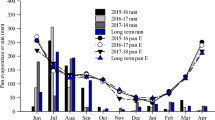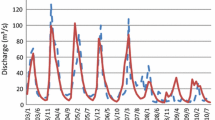Abstract
Uncertainty in future availability of irrigation water and regulation of nutrient amount, management strategies for irrigation and nitrogen (N) are essential to maximize the crop productivity. To study the response of irrigation and N on water productivity and economic return of maize (Zea mays L.) grain yield, an experiment was conducted at Water Management Research Center, University of Agriculture Faisalabad, Pakistan in 2015 and 2016. Treatments included of full and three reduced levels of irrigation, with four rates of N fertilization. An empirical model was developed using observed grain yield for irrigation and N levels. Results from model and economic analysis showed that the N rates of 235, 229, 233, and 210 kg ha−1 were the most economical optimum N rates to achieve the economic yield of 9321, 8937, 5748, and 3493 kg ha−1 at 100%, 80%, 60%, and 40% irrigation levels, respectively. Economic optimum N rates were further explored to find out the optimum level of irrigation as a function of the total water applied using a quadratic equation. The results showed that 520 mm is the optimum level of irrigation for the entire growing season in 2015 and 2016. Results also revealed that yield is not significantly affected by reducing the irrigation from full irrigation to 80% of full irrigation. It is concluded from the study that the relationship between irrigation and N can be used for efficient management of irrigation and N and to reduce the losses of N to avoid the economic loss and environmental hazards. The empirical equation can help farmers to optimize irrigation and N to obtain maximum economic return in semi-arid regions with sandy loam soils.


Similar content being viewed by others
References
Abbas G, Hussain A, Ahmad A, Wajid A (2005) Effect of irrigation schedules and nitrogen rates on yield and yield components of maize. J Agric Soc Sci 1:335–338
Abu-allaban M, El-naqa A, Jaber M, Hammouri N (2015) Water scarcity impact of climate change in semi-arid regions: a case study in Mujib basin, Jordan. Arab J Geosci 8:951–959
Agriculture management system punjab (2016) Cost of production of maize crop estimate under average conditions in the Punjab-Pakistan. Available at: http://www.amis.pk.htm
Amiri S, Gheysari M, Trooien TP (2015) Maize response to a deficit-irrigation strategy in a dry region. Agr Ecosyst Environ 5:1–12
Ashraf U, Salim MN, Sher A (2016) Maize growth, yield formation and water-nitrogen usage in response to varied irrigation and nitrogen supply under semi-arid climate. Turk J Agric For 21:88–96
Bashir MT, Ali S, Ghauri M (2013) Impact of excessive nitrogen fertilizers on the environment and associated mitigation strategies. Asian J Microbiol Biotech Env Sc 15:213–221
Bastida F, Torres IF, Romero-Trigueros C (2017) Combined effects of reduced irrigation and water quality on the soil microbial community of a citrus orchard under semi-arid conditions. Soil Biol Biochem 104:226–237
Bennett JM, Mutti LSM, Rao PSC, Jones JW (1989) Interactive effects of nitrogen and water stresses on biomass accumulation, nitrogen uptake, and seed yield of maize. Field Crop Res 19:297–311
Biswas DK, Ma B (2016) Effect of nitrogen rate and fertilizer nitrogen source on physiology, yield, grain quality, and nitrogen use efficiency in corn. Can J Plant Sci 403:392–403
Bizikova L, Julie JP (2015) Review of key initiatives and approaches to adaptation planning at the national level in semi-arid areas. Reg Environ Chang 15:837–850
Bremne JM (1960) Method, determination of nitrogen in soil by the Kjeldahl. J Agric Sci 55:11–33
Çakir R (2004) Effect of water stress at different development stages on vegetative and reproductive growth of corn. Field Crop Res 89:1–16
Cook S, Gichuki F, Turral H (2006) Water productivity: estimation at plot, farm and basin scale basin focal project working paper. Nutri Cycl Agroecosyst 5:144–156
Derby NE, Steele DD, Terpstra J (2005) Interactions of nitrogen, weather, soil, and irrigation on corn yield. Agron J 97:1342–1351
Ding L, Wang KJ, Jiang GM et al (2005) Effects of nitrogen deficiency on photosynthetic traits of maize hybrids released in different years. Ann Bot 96:925–930
Domínguez A, De Juan JA, Tarjuelo JM (2012) Determination of optimal regulated deficit irrigation strategies for maize in a semi-arid environment. Agric Water Manag 110:67–77
El Zubair RM, Fadlalla B, Hussien A (2015) Effect of different nitrogen fertilization levels on yield of maize (Zea mays L.) as winter forage. Int J Sci Technol Res 4:197–201
Farooq M, Wahid A, Kobayashi N, Fujita D, Basra SMA (2009) Review article plant drought stress: effects, mechanisms and management. Agron Sustain Dev 29:185–212
Fereres E, De Rabanales CU (2007) Deficit irrigation for reducing agricultural water use. J Exp Bot 58:147–159
Geerts S, Raes D (2009) Deficit irrigation as an on-farm strategy to maximize crop water productivity in dry areas. Agric Water Manag 96:1275–1284
Gonzalez-Dugo V, Durand J-L, Gastal F (2010) Water deficit and nitrogen nutrition of crops. A review. Agron Sustain Dev 30:529–544
Government of Pakistan (2017) Economic survey of Pakistan, economic advisory wing, finance division. Govt of Pakistan, Pakistan, pp 29–30
Hammad AH, Ahmad A, Azhar F (2011) Optimizing water and nitrogen requirement in maize (Zea mays L.) under semi arid conditions of Pakistan. Pak J Bot 43:2919–2923
Hammad HM, Ahmad A, Abbas F, Farhad W (2012) Optimizing water and nitrogen use for maize production under semiarid conditions. Turk J Agric For 36:519–532
Harder HJ, Carlson RE, Shaw RH (2002) Yield, yield components, and nutrient content of corn grain as influenced by post-silking moisture stress. Agron J 74:275–278
Hassan SW, Oad FC, Tunio SD (2010) Impact of nitrogen levels and application methods on agronomic, physiological and nutrient uptake traits of maize fodder. Pak J Bot 42:4095–4101
Hirel B, Tétu T, Lea PJ, Dubois F (2011) Improving nitrogen use efficiency in crops for sustainable agriculture. sustainability 3:1452–1485
Homer C and Pratt FP (1961) Methods of analysis for soils, plants and waters. Agricultural research division, 3rd edn. Wiley, New York, pp 1–76
Irmak S, Djaman K, Rudnick DR (2016) Effect of full and limited irrigation amount and frequency on subsurface drip - irrigated maize evapotranspiration, yield, water use efficiency and yield response factors. Irrig Sci 34:271–286
Johnson AI (1962) Methods of measuring soil moisture in the field, 2nd edn. Government Printing Office, USA, pp 1–24
Kaplan M, Baran O, Unlukara A (2016) The effect of different nitrogen doses and irrigation levels on yield, nutritive value, fermentation and gas production of corn silage. Turk J F Crop 21:100–108
Kar G, Kumar A, Mohapatra S (2014) Radiation utilization efficiency, nitrogen uptake and modeling crop growth and yield of rainfed rice under different nitrogen rates. J Indian Soc Soil Sci 62:108–117
Karkanis PG (1983) Determining field capacity and wilting point using soil saturation by capillary rise. Can Agric Eng 25:19–21
Khaliq T, Ahmad A, Hussain A, Ali MA (2009) Maize hybrids response to nitrogen rates at multiple locations in semiarid environment. Pak J Bot 41:207–224
Khan HZ, Iqbal S, Iqbal A (2011) Response of maize (Zea mays L.) varieties to different levels of nitrogen. Crop Env 2:15–19
Kibe AM, Singh S, Kalra N (2006) Water-nitrogen relationships for wheat growth and productivity in late sown conditions. Agric Water Manag 84:221–228
Kokab RU, Nawaz A (2013) Indus water treaty: need for review. Asian J Soc Sci 2:210–218
Kuşçu H, Demir AO (2012) Responses of maize to full and limited irrigation at different plant growth stages. Tätigk ber Nat forsch Ges Baselland 27:15–27
Majnooni-heris A, Nazemi AH, Sadraddini AA (2014) Effects of deficit irrigation on the yield, yield components, water and irrigation water use efficiency of spring canola. J Biol Environ Sci 5:44–53
Mancosu N, Snyder RL, Kyriakakis G, Spano D (2015) Water scarcity and future challenges for food production. Water 7:975–992
Mehlich A (1953) Determination of P, Ca, Mg, K, Na, and NH4. North Carolina Soil Test Division, USA, pp 23–89
Meskelu E, Mohammed M, Hordofa T (2014) Response of maize (Zea mays L.) for moisture stress condition at different growth stages. Int J Recent Res Life Sci 1:12–21
Monheit AC (2011) Running on empty. J Health Care Org 48:177–182
Moodie G, Smith WRM (1959) Laboratory manual for soil fertility. Department of Agronomy, Washington State University, USA, pp 31–39
Naheed G, Mahmood A (2006) Water requirement of wheat crop in Pakistan. Pak J Meteorol 6:89–97
Nguyen GN, Sutton BG (2009) Water deficit reduced fertility of young microspores resulting in a decline of viable mature pollen and grain set in rice. J Agron Crop Sci 195:11–18
Pandey RK, Maranville JW, Admou A (2000) Deficit irrigation and nitrogen effects on maize in a Sahelian environment I. Grain yield and yield components. Agric Water Manag 46:1–13
Randhawa MS, Maqsood M, Wajid SA, Anwar-ul-haq M (2012) Effect of integrated plant nutrition and irrigation scheduling on yield and yield component of maize (Zea mays L.). Pakistan journan Agric Sci 49:267–273
Saeed U, Wajid SA, Khaliq T, Zahir ZA (2017) Optimizing irrigation and nitrogen for wheat through empirical modeling under semi-arid environment. Environ Sci Pollut Res 24:11663–11676
Sajedi N, Ardakani MR, Naderi A (2009) Response of maize to nutrients foliar application under water deficit stress conditions. Am J Agric Biol Sci 4:242–248
SAS Institute (2013) SAS/STAT user’s guide: statistics, version 9.4. SAS Institute, Cary, North Carolina State University, USA, pp 25–75
Sharar MS, Ayub M, Nadeem MA, Ahmad N (2003) Effect of different rates of nitrogen and phosphorus on growth and grain yield of maize (Zea mays L.). Asian J Plant Sci 2:347–349
Singh J, Hadda MS (2016) Physiological growth indices of maize under semi-arid irrigated conditions as influenced by subsoil compaction and physiological growth indices of maize under semi-arid irrigated conditions as influenced by subsoil compaction and nitrogen. Proc Int Congr Ecol 10:15–33
Skogerboe G V, Hyatt ML, Anderson RK, Eggleston KO (1967) Design and calibration of submerged open channel flow measurement structures: part 3-cutthroat flumes, 3rd edn. Utah State University Logan, Utah, pp 1-36
Tah M, Tanv A, A A WA (2008) Comparative yield performance of different maize (Zea mays L.) hybrids under local conditions of Faisalabad-Pakistan. Pak J life Sci 6:118–120
Wang GL, Ye YL, Chen XP, Cui ZL (2014) Determining the optimal nitrogen rate for summer maize in China by integrating agronomic, economic, and environmental aspects. Biogeosciences 11:3031–3041
Watson DJ (1947) Comparative physiological studies on the growth of field crops. 1. Variation in net assimilation rate and leaf area between species and varieties, and within and between years. Ann Bot 11:41–76
Wight JR, Hanks RJ (2003) A water-balance, climate model for range herbage production. J Range Manag 34:307–311
Xiukang W (2017) Effects of irrigation and nitrogen on maize growth and yield components. Glob Chang Nat Dis Mang Geo Info Tech 5: 63–74
Yin G, Gu J, Zhang F (2014) Maize yield response to water supply and fertilizer input in a semi-arid environment of Northeast China. PLoS One 9:1–6
Acknowledgements
The authors are grateful to the staff of Water Management Research Institute (WMRI), University of Agriculture Faisalabad-Pakistan (UAF) for their support in conducting the experiment. The authors would like to thank all researchers of Agro-Climatology Lab, Department of Agronomy, UAF, for technical guidance. We also thank to Mr. Mohammad Hassan Fallah of Research Scientist Crop Ecology, Ferdowsi University of Mashhad, Iran for helping us in statistical data analysis.
Author information
Authors and Affiliations
Corresponding author
Additional information
Responsible editor: Philippe Garrigues
Rights and permissions
About this article
Cite this article
Ahmad, I., Wajid, S.A., Ahmad, A. et al. Optimizing irrigation and nitrogen requirements for maize through empirical modeling in semi-arid environment. Environ Sci Pollut Res 26, 1227–1237 (2019). https://doi.org/10.1007/s11356-018-2772-x
Received:
Accepted:
Published:
Issue Date:
DOI: https://doi.org/10.1007/s11356-018-2772-x




